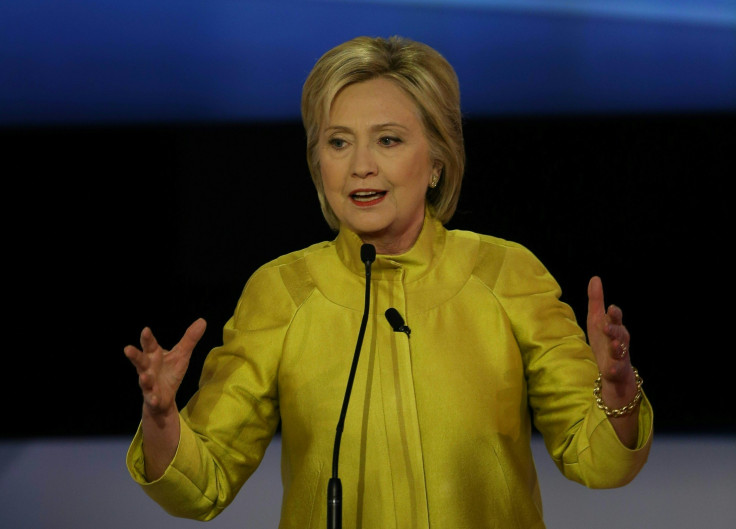Sanders Surging In Nevada? Clinton Campaign Lowers Expectations As Democrats Vie For Latino Votes

Hillary Clinton may have reason to worry about Nevada. Now that the first two presidential nominating contests in Iowa and New Hampshire are over, the Democratic presidential candidates are pushing ahead to the states in the West and South. Up next is the Nevada Democratic caucus, as well as the South Carolina primary, Feb. 20, and while early polling has suggested the former secretary of state has a large lead in the Silver State, the campaigns’ recent actions and political analysts suggest the race will likely be much closer than it seems.
The first indication Clinton’s campaign was getting nervous about her chances in Nevada came this week when several campaign officials painted the race as likely to be close because Nevada has lots of white voters, like New Hampshire and Iowa. Her opponent, Vermont Sen. Bernie Sanders, beat her by double digits in New Hampshire and nearly tied her in Iowa, which has caused Clinton to re-evaluate aspects of her campaign’s strategy and message.
Clinton spokesman Brian Fallon said of Nevada and South Carolina in an interview on MSNBC Tuesday morning the campaign expects “a narrowing in both places — we’re clear-eyed about that,” BuzzFeed News reported. “There’s an important Hispanic element to the Democratic caucus in Nevada. But it’s still a state that is 80 percent white voters. You have a caucus-style format, and he’ll have the momentum coming out of New Hampshire presumably, so there’s a lot of reasons he should do well.”
Podesta and Mook also suggested to donors that Nevada will be a tight race; said demographics of state are close to Iowa, per source on call
— Liz Kreutz (@ABCLiz) February 11, 2016
These comments raised the eyebrows of many in the politics world because Nevada’s population is about 27 percent Hispanic, with African-Americans and Asian/Pacific Islanders each making up just under 10 percent of the population. The Democratic electorate in the state is about 20 percent Hispanic and 13 percent African-American, the New York Times reported this week. These numbers all look very different from those in Iowa and New Hampshire, which both have white populations in the 90 percent range.
Furthermore, exit polls in 2008 showed the Democratic caucus population that year was 35 percent minority, Nevada political journalist Jon Ralston pointed out Thursday in a searing criticism of the Clinton campaign’s attempt to lower expectations. Senate Minority Leader Harry Reid of Nevada also weighed in Thursday, telling CNN Clinton’s team was “way behind the times” if it thought his state was not ethnically diverse.
But that’s not all. In Reid’s interview with CNN, he said he expected the race in Nevada to be very close, and a new poll out Friday gives some indication he may be right. There has been very little reliable polling in Nevada, with the last reputable survey being a Gravis Marketing poll Dec. 28 that indicated Clinton led Sanders 50 percent to 27 percent.
The conservative Washington Free Beacon, however, released a poll Friday that indicated Clinton and Sanders are tied at 45 percent support among likely Nevada caucusgoers. Many are likely to be skeptical of this poll because of the publication’s known conservative bias, but Ralston, widely considered Nevada’s top political expert, argued Friday the poll could give a serious indication about Sanders’ increasing popularity in the Silver State.
The poll was conducted by TargetPoint consulting and included interviews with 1,236 likely Nevada caucusgoers Feb. 8-10 with an error rate of 2.9 percentage points. It included automated phone calls and cell phone calls, polling documents released by the Free Beacon showed.
There are questions in the poll that could easily be seen as anti-Clinton and might influence respondents’ opinions, but those came after the initial questions about whom respondents supported in the race. That means those answering the survey answered who they supported before hearing questions that might inject bias .
The crosstabs of the poll do not show a race breakdown, but Sanders led Clinton among young voters and the sample was heavily female, which means the female vote — which has been an issue for Clinton — was split. There were also a significant number of new voter registrations in 2015, which could be important because Nevada is a caucus state and the results will rely heavily on turnout. So far, that has been an area that has allowed Sanders to do well in Iowa and New Hampshire.
In terms of advertising in Nevada, Clinton and Sanders are about equal on spending, Ralston reported Friday. Sanders has spent $3.6 million and Clinton has spent $3.3 million, with $1.8 million from each candidate going toward ads that will run through the caucuses.
None of these indicators is certain, but they also come at a time when the Democratic campaigns have been battling over Latino endorsements in Nevada as they seek to boost their immigration credentials. Last week, surrogates for the two campaigns fought on Twitter over prominent immigration activist Astrid Silva choosing to endorse Clinton.
Sanders campaign tries to throw cold water on @Astrid_NV endorsement of Hillary. This was RT by official account. https://t.co/l18Yz34S6N
— Jon Ralston (@RalstonReports) February 3, 2016
.@astrid_NV your courage and activism make a real difference. Honored to fight beside you—you're part of this team, not a press hit.
— Hillary Clinton (@HillaryClinton) February 3, 2016
With the race getting tighter and Sanders continuing to ramp up his efforts to appeal to people of color, these types of clashes are likely to continue as the Nevada caucuses grow closer. Clinton was scheduled to be in Nevada campaigning this weekend while Sanders was in Minnesota Friday and was set to head to Colorado Saturday.
© Copyright IBTimes 2024. All rights reserved.






















